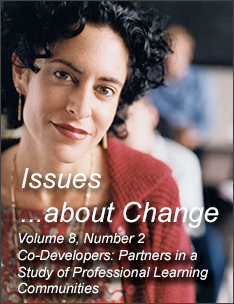Credits, References, and Disclaimer
Credits
This edition of Issues...about Change was written by D'Ette Cowan, Program Specialist at SEDL and Melissa Capers.
This publication may be reproduced and copies distributed to others. Please acknowledge SEDL as the source on all copies. For best results printing this publication, please access the PDF Version of this document.
Photo © copyright 1997 COMSTOCK.
References
- Bryk, A. S., Easton, J. Q., Kerbow, D., Rollow, S. G., & Sebring, P. A. (1994). The state of Chicago school reform. Phi Delta Kappan, 76(1), 74-78.
- DuFour, R., & Eaker, R. (1998). Professional learning communities at work: Best practices for enhancing student achievement. Reston, VA: Association for Supervision and Curriculum Development.
- Elmore, R. F. (1996). Getting to scale with good educational practice. Harvard Educational Review, 66(1), 1-26.
- Fullan, M. (1999). Change forces: The sequel. Philadelphia, PA: Falmer.
- Hord, S. M. (1997). Professional learning communities: Communities of continuous inquiry and improvement. Austin, TX: Southwest Educational Development Laboratory.
- Hord, S. M. (1999). Assessing a school staff as a community of professional learners. Issues... About Change, 7(1). Austin, TX: Southwest Educational Development Laboratory.
- Kruse, S., & Louis, K. S. (1995). Developing professional community in new and restructuring schools. In K. S. Louis, S. Kruse & Associates, Professionalism and community: Perspectives on reforming urban schools (pp. 187-207). Thousand Oaks, CA: Corwin Press.
- Lee, V. E., Smith, J. B., & Croninger, R. G. (1995, Fall). Another look at high school restructuring. Issues in Restructuring Schools. Madison: University of Wisconsin-Madison, Center on Organization and Restructuring of Schools.
- Lieberman, A. (Ed.). The work of restructuring schools: Building from the ground up. New York: Teachers College Press.
- Louis, K. S., Toole, J., & Hargreaves, A. (2000). Rethinking school improvement. In J. Murphy & K. S. Louis (Eds.), Handbook of research on educational administration (2nd ed., pp. 251-276). San Francisco: Jossey-Bass.
- McLaughlin, M. W. (1993). What matters most in teachers' workplace context? In J. W. Little & M. W. McLaughlin (Eds.), Teachers' work: Individuals, colleagues, and contexts. (pp. 79-103). New York: Teachers College Press.
Notes
1 For more information about research that supports schools as professional learning communities, see Hord, 1997.
2An initiative developed in a past laboratory contract that focused on strategies principals used to influence change.
3"Scaling up" refers to the process of developing, incorporating, and extending new ideas about teaching and learning in more than a few schools.
4These readiness stages were largely determined by the extent to which the principal shared decision making among the whole staff and the degree to which a culture of continuous inquiry existed.
5 Refer to SEDL website (http://www.sedl.org) for information on future publications and conferences related to the CCCII project.
Disclaimer
This publication is based on work sponsored wholly, or in part, by the Office of Educational Research & Improvement, U.S. Department of Education, under Contract Number RJ9600681. The contents of this publication do not necessarily reflect the views of OERI, the Department, or any other agency of the U. S. Government.

